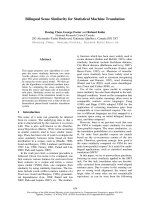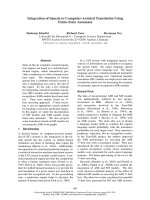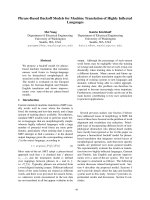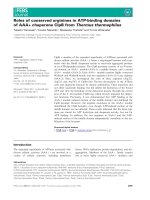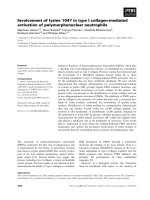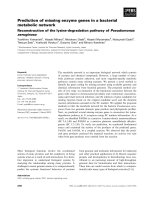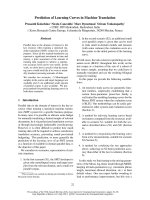Báo cáo khoa học: "Prediction of Learning Curves in Machine Translation" ppt
Bạn đang xem bản rút gọn của tài liệu. Xem và tải ngay bản đầy đủ của tài liệu tại đây (390.52 KB, 9 trang )
Proceedings of the 50th Annual Meeting of the Association for Computational Linguistics, pages 22–30,
Jeju, Republic of Korea, 8-14 July 2012.
c
2012 Association for Computational Linguistics
Prediction of Learning Curves in Machine Translation
Prasanth Kolachina
∗
Nicola Cancedda
†
Marc Dymetman
†
Sriram Venkatapathy
†
∗ LTRC, IIIT-Hyderabad, Hyderabad, India
† Xerox Research Centre Europe, 6 chemin de Maupertuis, 38240 Meylan, France
Abstract
Parallel data in the domain of interest is the
key resource when training a statistical ma-
chine translation (SMT) system for a specific
purpose. Since ad-hoc manual translation can
represent a significant investment in time and
money, a prior assesment of the amount of
training data required to achieve a satisfac-
tory accuracy level can be very useful. In this
work, we show how to predict what the learn-
ing curve would look like if we were to manu-
ally translate increasing amounts of data.
We consider two scenarios, 1) Monolingual
samples in the source and target languages are
available and 2) An additional small amount
of parallel corpus is also available. We pro-
pose methods for predicting learning curves in
both these scenarios.
1 Introduction
Parallel data in the domain of interest is the key re-
source when training a statistical machine transla-
tion (SMT) system for a specific business purpose.
In many cases it is possible to allocate some budget
for manually translating a limited sample of relevant
documents, be it via professional translation services
or through increasingly fashionable crowdsourcing.
However, it is often difficult to predict how much
training data will be required to achieve satisfactory
translation accuracy, preventing sound provisional
budgetting. This prediction, or more generally the
prediction of the learning curve of an SMT system
as a function of available in-domain parallel data, is
the objective of this paper.
We consider two scenarios, representative of real-
istic situations.
1. In the first scenario (S1), the SMT developer is
given only monolingual source and target sam-
ples from the relevant domain, and a small test
parallel corpus.
∗
This research was carried out during an internship at Xerox
Research Centre Europe.
2. In the second scenario (S2), an additional small
seed parallel corpus is given that can be used
to train small in-domain models and measure
(with some variance) the evaluation score at a
few points on the initial portion of the learning
curve.
In both cases, the task consists in predicting an eval-
uation score (BLEU, throughout this work) on the
test corpus as a function of the size of a subset of
the source sample, assuming that we could have it
manually translated and use the resulting bilingual
corpus for training.
In this paper we provide the following contribu-
tions:
1. An extensive study across six parametric func-
tion families, empirically establishing that a
certain three-parameter power-law family is
well suited for modeling learning curves for the
Moses SMT system when the evaluation score
is BLEU. Our methodology can be easily gen-
eralized to other systems and evaluation scores
(Section 3);
2. A method for inferring learning curves based
on features computed from the resources avail-
able in scenario S1, suitable for both the sce-
narios described above (S1) and (S2) (Section
4);
3. A method for extrapolating the learning curve
from a few measurements, suitable for scenario
S2 (Section 5);
4. A method for combining the two approaches
above, achieving on S2 better prediction accu-
racy than either of the two in isolation (Section
6).
In this study we limit tuning to the mixing param-
eters of the Moses log-linear model through MERT,
keeping all meta-parameters (e.g. maximum phrase
length, maximum allowed distortion, etc.) at their
default values. One can expect further tweaking to
lead to performance improvements, but this was a
22
necessary simplification in order to execute the tests
on a sufficiently large scale.
Our experiments involve 30 distinct language pair
and domain combinations and 96 different learning
curves. They show that without any parallel data
we can predict the expected translation accuracy at
75K segments within an error of 6 BLEU points (Ta-
ble 4), while using a seed training corpus of 10K
segments narrows this error to within 1.5 points (Ta-
ble 6).
2 Related Work
Learning curves are routinely used to illustrate how
the performance of experimental methods depend
on the amount of training data used. In the SMT
area, Koehn et al. (2003) used learning curves to
compare performance for various meta-parameter
settings such as maximum phrase length, while
Turchi et al. (2008) extensively studied the be-
haviour of learning curves under a number of test
conditions on Spanish-English. In Birch et al.
(2008), the authors examined corpus features that
contribute most to the machine translation perfor-
mance. Their results showed that the most predic-
tive features were the morphological complexity of
the languages, their linguistic relatedness and their
word-order divergence; in our work, we make use of
these features, among others, for predicting transla-
tion accuracy (Section 4).
In a Machine Learning context, Perlich et al.
(2003) used learning curves for predicting maximum
performance bounds of learning algorithms and to
compare them. In Gu et al. (2001), the learning
curves of two classification algorithms were mod-
elled for eight different large data sets. This work
uses similar a priori knowledge for restricting the
form of learning curves as ours (see Section 3), and
also similar empirical evaluation criteria for compar-
ing curve families with one another. While both ap-
plication and performance metric in our work are
different, we arrive at a similar conclusion that a
power law family of the form y = c − a x
−α
is a
good model of the learning curves.
Learning curves are also frequently used for de-
termining empirically the number of iterations for
an incremental learning procedure.
The crucial difference in our work is that in the
previous cases, learning curves are plotted a poste-
riori i.e. once the labelled data has become avail-
able and the training has been performed, whereas
in our work the learning curve itself is the object of
the prediction. Our goal is to learn to predict what
the learning curve will be a priori without having to
label the data at all (S1), or through labelling only a
very small amount of it (S2).
In this respect, the academic field of Computa-
tional Learning Theory has a similar goal, since it
strives to identify bounds to performance measures
1
,
typically including a dependency on the training
sample size. We take a purely empirical approach
in this work, and obtain useful estimations for a case
like SMT, where the complexity of the mapping be-
tween the input and the output prevents tight theo-
retical analysis.
3 Selecting a parametric family of curves
The first step in our approach consists in selecting
a suitable family of shapes for the learning curves
that we want to produce in the two scenarios being
considered.
We formulate the problem as follows. For a cer-
tain bilingual test dataset d, we consider a set of
observations O
d
= {(x
1
, y
1
), (x
2
, y
2
) (x
n
, y
n
)},
where y
i
is the performance on d (measured using
BLEU (Papineni et al., 2002)) of a translation model
trained on a parallel corpus of size x
i
. The corpus
size x
i
is measured in terms of the number of seg-
ments (sentences) present in the parallel corpus.
We consider such observations to be generated by
a regression model of the form:
y
i
= F (x
i
; θ) +
i
1 ≤ i ≤ n (1)
where F is a function depending on a vector param-
eter θ which depends on d, and
i
is Gaussian noise
of constant variance.
Based on our prior knowledge of the problem,
we limit the search for a suitable F to families that
satisfies the following conditions- monotonically in-
creasing, concave and bounded. The first condition
just says that more training data is better. The sec-
ond condition expresses a notion of “diminishing
returns”, namely that a given amount of additional
training data is more advantageous when added to
a small rather than to a big amount of initial data.
The last condition is related to our use of BLEU —
which is bounded by 1 — as a performance mea-
sure; It should be noted that some growth patterns
which are sometimes proposed, such as a logarith-
mic regime of the form y a + b log x, are not
1
More often to a loss, which is equivalent.
23
compatible with this constraint.
We consider six possible families of functions sat-
isfying these conditions, which are listed in Table 1.
Preliminary experiments indicated that curves from
Model Formula
Exp
3
y = c − e
−ax+b
Exp
4
y = c − e
−ax
α
+b
ExpP
3
y = c − e
(x−b)
α
Pow
3
y = c − ax
−α
Pow
4
y = c − (−ax + b)
−α
ILog
2
y = c − (a/ log x)
Table 1: Curve families.
the “Power” and “Exp” family with only two param-
eters underfitted, while those with five or more pa-
rameters led to overfitting and solution instability.
We decided to only select families with three or four
parameters.
Curve fitting technique Given a set of observa-
tions {(x
1
, y
1
), (x
2
, y
2
) (x
n
, y
n
)} and a curve fam-
ily F (x; θ) from Table 1, we compute a best fit
ˆ
θ
where:
ˆ
θ = arg min
θ
n
i=1
[y
i
− F (x
i
; θ)]
2
, (2)
through use of the Levenberg-Marquardt
method (Mor
´
e, 1978) for non-linear regression.
For selecting a learning curve family, and for all
other experiments in this paper, we trained a large
number of systems on multiple configurations of
training sets and sample sizes, and tested each on
multiple test sets; these are listed in Table 2. All
experiments use Moses (Koehn et al., 2007).
2
Domain
Source Target # Test
Language Language sets
Europarl (Koehn, 2005)
Fr, De, Es En
4
En Fr, De, Es
KFTT (Neubig, 2011) Jp, En En, Jp 2
EMEA (Tiedemann, 2009) Da, De En 4
News (Callison-Burch et al., 2011) Cz,En,Fr,De,Es Cz,En,Fr,De,Es 3
Table 2: The translation systems used for the curve fit-
ting experiments, comprising 30 language-pair and do-
main combinations for a total of 96 learning curves.
Language codes: Cz=Czech, Da=Danish, En=English,
De=German, Fr=French, Jp=Japanese, Es=Spanish
The goodness of fit for each of the families is eval-
2
The settings used in training the systems are those
described in />baseline.html
uated based on their ability to i) fit over the entire set
of observations, ii) extrapolate to points beyond the
observed portion of the curve and iii) generalize well
over different datasets .
We use a recursive fitting procedure where the
curve obtained from fitting the first i points is used
to predict the observations at two points: x
i+1
, i.e.
the point to the immediate right of the currently ob-
served x
i
and x
n
, i.e. the largest point that has been
observed.
The following error measures quantify the good-
ness of fit of the curve families:
1. Average root mean-squared error (RMSE):
1
N
c∈S
t∈T
c
1
n
n
i=1
[y
i
− F (x
i
;
ˆ
θ)]
2
1/2
ct
where S is the set of training datasets, T
c
is the
set of test datasets for training configuration c,
ˆ
θ is as defined in Eq. 2, N is the total number
of combinations of training configurations and
test datasets, and i ranges on a grid of training
subset sizes.The expressions n, x
i
, y
i
,
ˆ
θ are all
local to the combination ct.
2. Average root mean squared residual at next
point X = x
i+1
(NPR):
1
N
c∈S
t∈T
c
1
n − k − 1
n−1
i=k
[y
i+1
− F (x
i+1
;
ˆ
θ
i
)]
2
1/2
ct
where
ˆ
θ
i
is obtained using only observations
up to x
i
in Eq. 2 and where k is the number of
parameters of the family.
3
3. Average root mean squared residual at the last
point X = x
n
(LPR):
1
N
c∈S
t∈T
c
1
n − k − 1
n−1
i=k
[y
n
− F (x
n
;
ˆ
θ
i
)]
2
1/2
ct
Curve fitting evaluation The evaluation of the
goodness of fit for the curve families is presented
in Table 3. The average values of the root mean-
squared error and the average residuals across all the
learning curves used in our experiments are shown
in this table. The values are on the same scale as the
BLEU scores. Figure 1 shows the curve fits obtained
3
We start the summation from i = k, because at least k
points are required for computing
ˆ
θ
i
.
24
Figure 1: Curve fits using different curve families on a
test dataset
for all the six families on a test dataset for English-
German language pair.
Curve Family RMSE NPR LPR
Exp
3
0.0063 0.0094 0.0694
Exp
4
0.0030 0.0036 0.0072
ExpP
3
0.0040 0.0049 0.0145
Pow
3
0.0029 0.0037 0.0091
Pow
4
0.0026 0.0042 0.0102
ILog
2
0.0050 0.0067 0.0146
Table 3: Evaluation of the goodness of fit for the six fam-
ilies.
Loooking at the values in Table 3, we decided to
use the Pow
3
family as the best overall compromise.
While it is not systematically better than Exp
4
and
Pow
4
, it is good overall and has the advantage of
requiring only 3 parameters.
4 Inferring a learning curve from mostly
monolingual data
In this section we address scenario S1: we have
access to a source-language monolingual collec-
tion (from which portions to be manually translated
could be sampled) and a target-language in-domain
monolingual corpus, to supplement the target side of
a parallel corpus while training a language model.
The only available parallel resource is a very small
test corpus. Our objective is to predict the evolution
of the BLEU score on the given test set as a function
of the size of a random subset of the training data
that we manually translate
4
. The intuition behind
this is that the source-side and target-side mono-
lingual data already convey significant information
about the difficulty of the translation task.
We proceed in the following way. We first train
models to predict the BLEU score at m anchor sizes
s
1
, . . . , s
m
, based on a set of features globally char-
acterizing the configuration of interest. We restrict
our attention to linear models:
µ
j
= w
j
φ, j ∈ {1 . . . m}
where w
j
is a vector of feature weights specific to
predicting at anchor size j, and φ is a vector of size-
independent configuration features, detailed below.
We then perform inference using these models to
predict the BLEU score at each anchor, for the test
case of interest. We finally estimate the parameters
of the learning curve by weighted least squares re-
gression using the anchor predictions.
Anchor sizes can be chosen rather arbitrarily, but
must satisfy the following two constraints:
1. They must be three or more in number in order
to allow fitting the tri-parameter curve.
2. They should be spread as much as possible
along the range of sample size.
For our experiments, we take m = 3, with anchors
at 10K, 75K and 500K segments.
The feature vector φ consists of the following fea-
tures:
1. General properties: number and average length
of sentences in the (source) test set.
2. Average length of tokens in the (source) test set
and in the monolingual source language corpus.
3. Lexical diversity features:
(a) type-token ratios for n-grams of order 1 to
5 in the monolingual corpus of both source
and target languages
(b) perplexity of language models of order 2
to 5 derived from the monolingual source
corpus computed on the source side of the
test corpus.
4
We specify that it is a random sample as opposed to a subset
deliberately chosen to maximize learning effectiveness. While
there are clear ties between our present work and active learn-
ing, we prefer to keep these two aspects distinct at this stage,
and intend to explore this connection in future work.
25
4. Features capturing divergence between lan-
guages in the pair:
(a) average ratio of source/target sentence
lengths in the test set.
(b) ratio of type-token ratios of orders 1 to 5
in the monolingual corpus of both source
and target languages.
5. Word-order divergence: The divergence in the
word-order between the source and the target
languages can be captured using the part-of-
speech (pos) tag sequences across languages.
We use cross-entropy measure to capture sim-
ilarity between the n-gram distributions of the
pos tags in the monolingual corpora of the two
languages. The order of the n-grams ranges be-
tween n = 2, 4 . . . 12 in order to account for
long distance reordering between languages.
The pos tags for the languages are mapped to
a reduced set of twelve pos tags (Petrov et al.,
2012) in order to account for differences in
tagsets used across languages.
These features capture our intuition that translation
is going to be harder if the language in the domain
is highly variable and if the source and target lan-
guages diverge more in terms of morphology and
word-order.
The weights w
j
are estimated from data. The
training data for fitting these linear models is ob-
tained in the following way. For each configuration
(combination of language pair and domain) c and
test set t in Table 2, a gold curve is fitted using the
selected tri-parameter power-law family using a fine
grid of corpus sizes. This is available as a byproduct
of the experiments for comparing different paramet-
ric families described in Section 3. We then compute
the value of the gold curves at the m anchor sizes:
we thus have m “gold” vectors µ
1
, . . . , µ
m
with ac-
curate estimates of BLEU at the anchor sizes
5
. We
construct the design matrix Φ with one column for
each feature vector φ
ct
corresponding to each com-
bination of training configuration c and test set t.
We then estimate weights w
j
using Ridge regres-
sion (L
2
regularization):
w
j
= arg min
w
||Φ
w − µ
j
||
2
+ C||w||
2
(3)
5
Computing these values from the gold curve rather than di-
rectly from the observations has the advantage of smoothing the
observed values and also does not assume that observations at
the anchor sizes are always directly available.
where the regularization parameter C is chosen by
cross-validation. We also run experiments using
Lasso (L
1
) regularization (Tibshirani, 1994) instead
of Ridge. As baseline, we take a constant mean
model predicting, for each anchor size s
j
, the av-
erage of all the µ
jct
.
We do not assume the difficulty of predicting
BLEU at all anchor points to be the same. To allow
for this, we use (non-regularized) weighted least-
squares to fit a curve from our parametric family
through the m anchor points
6
. Following (Croarkin
and Tobias, 2006, Section 4.4.5.2), the anchor con-
fidence is set to be the inverse of the cross-validated
mean square residuals:
ω
j
=
1
N
c∈S
t∈T
c
(φ
ct
w
\c
j
− µ
jct
)
2
−1
(4)
where w
\c
j
are the feature weights obtained by the
regression above on all training configurations ex-
cept c, µ
jct
is the gold value at anchor j for train-
ing/test combination c, t, and N is the total number
of such combinations
7
. In other words, we assign to
each anchor point a confidence inverse to the cross-
validated mean squared error of the model used to
predict it.
For a new unseen configuration with feature vec-
tor φ
u
, we determine the parameters θ
u
of the corre-
sponding learning curve as:
θ
u
= arg min
θ
j
ω
j
F (s
j
; θ) − φ
u
w
j
2
(5)
5 Extrapolating a learning curve fitted on
a small parallel corpus
Given a small “seed” parallel corpus, the translation
system can be used to train small in-domain models
and the evaluation score can be measured at a few
initial sample sizes {(x
1
, y
1
), (x
2
, y
2
) (x
p
, y
p
)}.
The performance of the system for these initial
points provides evidence for predicting its perfor-
mance for larger sample sizes.
In order to do so, a learning curve from the fam-
ily Pow
3
is first fit through these initial points. We
6
When the number of anchor points is the same as the num-
ber of parameters in the parametric family, the curve can be fit
exactly through all anchor points. However the general discus-
sion is relevant in case there are more anchor points than pa-
rameters, and also in view of the combination of inference and
extrapolation in Section 6.
7
Curves on different test data for the same training configu-
ration are highly correlated and are therefore left out.
26
assume that p ≥ 3 for this operation to be well-
defined. The best fit ˆη is computed using the same
curve fitting as in Eq. 2.
At each individual anchor size s
j
, the accuracy of
prediction is measured using the root mean-squared
error between the prediction of extrapolated curves
and the gold values:
1
N
c∈S
t∈T
c
[F (s
j
; ˆη
ct
) − µ
ctj
]
2
1/2
(6)
where ˆη
ct
are the parameters of the curve fit using
the initial points for the combination ct.
In general, we observed that the extrapolated
curve tends to over-estimate BLEU for large sam-
ples.
6 Combining inference and extrapolation
In scenario S2, the models trained from the seed par-
allel corpus and the features used for inference (Sec-
tion 4) provide complementary information. In this
section we combine the two to see if this yields more
accurate learning curves.
For the inference method of Section 4, predictions
of models at anchor points are weighted by the in-
verse of the model empirical squared error (ω
j
). We
extend this approach to the extrapolated curves. Let
u be a new configuration with seed parallel corpus of
size x
u
, and let x
l
be the largest point in our grid for
which x
l
≤ x
u
. We first train translation models and
evaluate scores on samples of size x
1
, . . . , x
l
, fit pa-
rameters ˆη
u
through the scores, and then extrapolate
BLEU at the anchors s
j
: F (s
j
; ˆη
u
), j ∈ {1, . . . , m}.
Using the models trained for the experiments in Sec-
tion 3, we estimate the squared extrapolation error at
the anchors s
j
when using models trained on size up
to x
l
, and set the confidence in the extrapolations
8
for u to its inverse:
ξ
<l
j
=
1
N
c∈S
t∈T
c
(F (s
j
; η
<l
ct
) − µ
ctj
)
2
−1
(7)
where N, S, T
c
and µ
ctj
have the same meaning as
in Eq. 4, and η
<l
ct
are parameters fitted for config-
uration c and test t using only scores measured at
x
1
, . . . , x
l
. We finally estimate the parameters θ
u
of
8
In some cases these can actually be interpolations.
the combined curve as:
θ
u
= arg min
θ
j
ω
j
(F (s
j
; θ) − φ
u
w
j
)
2
+ ξ
<l
j
(F (s
j
; θ) − F(s
j
; ˆη
u
))
2
where φ
u
is the feature vector for u, and w
j
are the
weights we obtained from the regression in Eq. 3.
7 Experiments
In this section, we report the results of our experi-
ments on predicting the learning curves.
7.1 Inferred Learning Curves
Regression model 10K 75K 500K
Ridge 0.063 0.060 0.053
Lasso 0.054 0.060 0.062
Baseline 0.112 0.121 0.121
Table 4: Root mean squared error of the linear regression
models for each anchor size
In the case of inference from mostly monolingual
data, the accuracy of the predictions at each of the
anchor sizes is evaluated using root mean-squared
error over the predictions obtained in a leave-one-
out manner over the set of configurations from Ta-
ble 2. Table 4 shows these results for Ridge and
Lasso regression models at the three anchor sizes.
As an example, the model estimated using Lasso for
the 75K anchor size exhibits a root mean squared
error of 6 BLEU points. The errors we obtain are
lower than the error of the baseline consisting in tak-
ing, for each anchor size s
j
, the average of all the
µ
ctj
. The Lasso regression model selected four fea-
tures from the entire feature set: i) Size of the test
set (sentences & tokens) ii) Perplexity of language
model (order 5) on the test set iii) Type-token ratio
of the target monolingual corpus . Feature correla-
tion measures such as Pearsons R showed that the
features corresponding to type-token ratios of both
source and target languages and size of test set have
a high correlation with the BLEU scores at the three
anchor sizes.
Figure 2 shows an instance of the inferred learn-
ing curves obtained using a weighted least squares
method on the predictions at the anchor sizes. Ta-
ble 7 presents the cumulative error of the inferred
learning curves with respect to the gold curves, mea-
sured as the average distance between the curves in
the range x ∈ [0.1K, 100K].
27
Figure 2: Inferred learning curve for English-Japanese
test set. The error-bars show the anchor confidence for
the predictions.
7.2 Extrapolated Learning Curves
As explained in Section 5, we evaluate the accuracy
of predictions from the extrapolated curve using the
root mean squared error (see Eq. 6) between the pre-
dictions of this curve and the gold values at the an-
chor points.
We conducted experiments for three sets of initial
points, 1) 1K-5K-10K, 2) 5K-10K-20K, and 3) 1K-
5K-10K-20K. For each of these sets, we show the
prediction accuracy at the anchor sizes, 10K
9
, 75K,
and 500K in Table 5.
Initial Points 10K 75K 500K
1K-5K-10K 0.005 0.017 0.042
5K-10K-20K 0.002 0.015 0.034
1K-5K-10K-20K 0.002 0.008 0.019
Table 5: Root mean squared error of the extrapolated
curves at the three anchor sizes
The root mean squared errors obtained by extrap-
olating the learning curve are much lower than those
obtained by prediction of translation accuracy using
the monolingual corpus only (see Table 4), which
is expected given that more direct evidence is avail-
able in the former case . In Table 5, one can also
see that the root mean squared error for the sets 1K-
5K-10K and 5K-10K-20K are quite close for anchor
9
The 10K point is not an extrapolation point but lies within
the range of the set of initial points. However, it does give a
measure of the closeness of the curve fit using only the initial
points with the gold fit using all the points; the value of this gold
fit at 10K is not necessarily equal to the observation at 10K.
sizes 75K and 500K. However, when a configuration
of four initial points is used for the same amount of
“seed” parallel data, it outperforms both the config-
urations with three initial points.
7.3 Combined Learning Curves and Overall
Comparison
In Section 6, we presented a method for combin-
ing the predicted learning curves from inference and
extrapolation by using a weighted least squares ap-
proach. Table 6 reports the root mean squared error
at the three anchor sizes from the combined curves.
Initial Points Model 10K 75K 500K
1K-5K-10K
Ridge 0.005 0.015 0.038
Lasso 0.005 0.014 0.038
5K-10K-20K
Ridge 0.001 0.006 0.018
Lasso 0.001 0.006 0.018
1K-5K-10K-20K
Ridge 0.001 0.005 0.014
Lasso 0.001 0.005 0.014
Table 6: Root mean squared error of the combined curves
at the three anchor sizes
We also present an overall evaluation of all the
predicted learning curves. The evaluation metric is
the average distance between the predicted curves
and the gold curves, within the range of sample sizes
x
min
=0.1K to x
max
=500K segments; this metric is
defined as:
1
N
c∈S
t∈T
c
x
max
x=x
min
|F (x; ˆη
ct
) − F(x;
ˆ
θ
ct
)|
x
max
− x
min
where ˆη
ct
is the curve of interest,
ˆ
θ
ct
is the gold
curve, and x is in the range [x
min
, x
max
], with a step
size of 1. Table 7 presents the final evaluation.
Initial Points IR IL EC CR CL
1K-5K-10K 0.034 0.050 0.018 0.015 0.014
5K-10K-20K 0.036 0.048 0.011 0.010 0.009
1K-5K-10K-20K 0.032 0.049 0.008 0.007 0.007
Table 7: Average distance of different predicted
learning curves relative to the gold curve. Columns:
IR=“Inference using Ridge model”, IL=“Inference
using Lasso model”, EC=“Extrapolated curve”,
CR=“Combined curve using Ridge”, CL=“Combined
curve using Lasso”
We see that the combined curves (CR and CL)
perform slightly better than the inferred curves (IR
28
and IL) and the extrapolated curves (EC). The aver-
age distance is on the same scale as the BLEU score,
which suggests that our best curves can predict the
gold curve within 1.5 BLEU points on average (the
best result being 0.7 BLEU points when the initial
points are 1K-5K-10K-20K) which is a telling re-
sult. The distances between the predicted and the
gold curves for all the learning curves in our experi-
ments are shown in Figure 3.
Figure 3: Distances between the predicted and the gold
learning curves in our experiments across the range of
sample sizes. The dotted lines indicate the distance from
gold curve for each instance, while the bold line indi-
cates the 95
th
quantile of the distance between the curves.
IR=“Inference using Ridge model”, EC=“Extrapolated
curve”, CR=“Combined curve using Ridge”.
We also provide a comparison of the different pre-
dicted curves with respect to the gold curve as shown
in Figure 4.
Figure 4: Predicted curves in the three scenarios for
Czech-English test set using the Lasso model
8 Conclusion
The ability to predict the amount of parallel data
required to achieve a given level of quality is very
valuable in planning business deployments of statis-
tical machine translation; yet, we are not aware of
any rigorous proposal for addressing this need.
Here, we proposed methods that can be directly
applied to predicting learning curves in realistic sce-
narios. We identified a suitable parametric fam-
ily for modeling learning curves via an extensive
empirical comparison. We described an inference
method that requires a minimal initial investment in
the form of only a small parallel test dataset. For the
cases where a slightly larger in-domain “seed” par-
allel corpus is available, we introduced an extrapola-
tion method and a combined method yielding high-
precision predictions: using models trained on up to
20K sentence pairs we can predict performance on a
given test set with a root mean squared error in the
order of 1 BLEU point at 75K sentence pairs, and
in the order of 2-4 BLEU points at 500K. Consider-
ing that variations in the order of 1 BLEU point on
a same test dataset can be observed simply due to
the instability of the standard MERT parameter tun-
ing algorithm (Foster and Kuhn, 2009; Clark et al.,
2011), we believe our results to be close to what can
be achieved in principle. Note that by using gold
curves as labels instead of actual measures we im-
plicitly average across many rounds of MERT (14
for each curve), greatly attenuating the impact of the
instability in the optimization procedure due to ran-
domness.
For enabling this work we trained a multitude
of instances of the same phrase-based SMT sys-
tem on 30 distinct combinations of language-pair
and domain, each with fourteen distinct training
sets of increasing size and tested these instances on
multiple in-domain datasets, generating 96 learning
curves. BLEU measurements for all 96 learning
curves along with the gold curves and feature values
used for inferring the learning curves are available
as additional material to this submission.
We believe that it should be possible to use in-
sights from this paper in an active learning setting,
to select, from an available monolingual source, a
subset of a given size for manual translation, in such
a way at to yield the highest performance, and we
plan to extend our work in this direction.
29
References
Alexandra Birch, Miles Osborne, and Philipp Koehn.
2008. Predicting Success in Machine Translation.
In Proceedings of the 2008 Conference on Empirical
Methods in Natural Language Processing, pages 745–
754, Honolulu, Hawaii, October. Association for Com-
putational Linguistics.
Chris Callison-Burch, Philipp Koehn, Christof Monz,
and Omar Zaidan. 2011. Findings of the 2011 Work-
shop on Statistical Machine Translation. In Proceed-
ings of the Sixth Workshop on Statistical Machine
Translation, pages 22–64, Edinburgh, Scotland, July.
Association for Computational Linguistics.
Jonathan H. Clark, Chris Dyer, Alon Lavie, and Noah A.
Smith. 2011. Better Hypothesis Testing for Statis-
tical Machine Translation: Controlling for Optimizer
Instability. In Proceedings of the 49th Annual Meet-
ing of the Association for Computational Linguistics:
Human Language Technologies, pages 176–181, Port-
land, Oregon, USA, June. Association for Computa-
tional Linguistics.
Carroll Croarkin and Paul Tobias. 2006.
NIST/SEMATECH e-Handbook of Statistical Meth-
ods. NIST/SEMATECH, July. Available online:
/>George Foster and Roland Kuhn. 2009. Stabilizing
Minimum Error Rate Training. In Proceedings of the
Fourth Workshop on Statistical Machine Translation,
pages 242–249, Athens, Greece, March. Association
for Computational Linguistics.
Baohua Gu, Feifang Hu, and Huan Liu. 2001. Mod-
elling Classification Performance for Large Data Sets.
In Proceedings of the Second International Conference
on Advances in Web-Age Information Management,
WAIM ’01, pages 317–328, London, UK. Springer-
Verlag.
Philipp Koehn, Franz J. Och, and Daniel Marcu. 2003.
Statistical Phrase-Based Translation. In Proceedings
of Human Language Technologies: The 2003 Annual
Conference of the North American Chapter of the As-
sociation for Computational Linguistics, pages 48–54,
Edmonton, Canada, May. Association for Computa-
tional Linguistics.
Philipp Koehn, Hieu Hoang, Alexandra Birch, Chris
Callison-Burch, Marcello Federico, Nicola Bertoldi,
Brooke Cowan, Wade Shen, Christine Moran, Richard
Zens, Chris Dyer, Ondrej Bojar, Alexandra Con-
stantin, and Evan Herbst. 2007. Moses: Open Source
Toolkit for Statistical Machine Translation. In Pro-
ceedings of the 45th Annual Meeting of the Associ-
ation for Computational Linguistics Companion Vol-
ume Proceedings of the Demo and Poster Sessions,
pages 177–180, Prague, Czech Republic, June. Asso-
ciation for Computational Linguistics.
Philipp Koehn. 2005. Europarl: A Parallel Corpus for
Statistical Machine Translation. In Proceedings of the
10th Machine Translation Summit, Phuket, Thailand,
September.
Jorge J. Mor
´
e. 1978. The Levenberg-Marquardt Algo-
rithm: Implementation and Theory. Numerical Anal-
ysis. Proceedings Biennial Conference Dundee 1977,
630:105–116.
Graham Neubig. 2011. The Kyoto Free Translation
Task. />Kishore Papineni, Salim Roukos, Todd Ward, and Wei-
Jing Zhu. 2002. Bleu: a Method for Automatic Eval-
uation of Machine Translation. In Proceedings of 40th
Annual Meeting of the Association for Computational
Linguistics, pages 311–318, Philadelphia, Pennsylva-
nia, USA, July. Association for Computational Lin-
guistics.
Claudia Perlich, Foster J. Provost, and Jeffrey S. Si-
monoff. 2003. Tree Induction vs. Logistic Regres-
sion: A Learning-Curve Analysis. Journal of Machine
Learning Research, 4:211–255.
Slav Petrov, Dipanjan Das, and Ryan McDonald. 2012.
A Universal Part-of-Speech Tagset. In Proceedings
of the Eighth conference on International Language
Resources and Evaluation (LREC’12), Istanbul, May.
European Language Resources Association (ELRA).
Robert Tibshirani. 1994. Regression Shrinkage and Se-
lection Via the Lasso. Journal of the Royal Statistical
Society, Series B, 58:267–288.
J
¨
org Tiedemann. 2009. News from OPUS - A Collection
of Multilingual Parallel Corpora with Tools and Inter-
faces. In Recent Advances in Natural Language Pro-
cessing, volume V, pages 237–248. John Benjamins,
Amsterdam/Philadelphia, Borovets, Bulgaria.
Marco Turchi, Tijl De Bie, and Nello Cristianini. 2008.
Learning Performance of a Machine Translation Sys-
tem: a Statistical and Computational Analysis. In Pro-
ceedings of the Third Workshop on Statistical Machine
Translation, pages 35–43, Columbus, Ohio, June. As-
sociation for Computational Linguistics.
30



